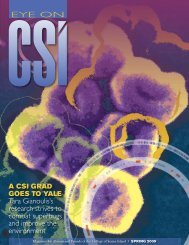csi undergraduate conference on research, scholarship ... - CSI Today
csi undergraduate conference on research, scholarship ... - CSI Today
csi undergraduate conference on research, scholarship ... - CSI Today
Create successful ePaper yourself
Turn your PDF publications into a flip-book with our unique Google optimized e-Paper software.
Research Paper Presentati<strong>on</strong>sEnvir<strong>on</strong>mental Studies:Biology, History, and CultureRoom 222, 3:00pm–4:30pmP A P E R 4L<strong>on</strong>g Distance Dispersal—AMechanism for Range Expansi<strong>on</strong>Brian KatemanFaculty Mentor: Dr. Shaibal MitraDepartment of BiologyDispersal is of ecological and evoluti<strong>on</strong>arysignificance for many areas in populati<strong>on</strong> biology,including populati<strong>on</strong> synchr<strong>on</strong>y, range expansi<strong>on</strong>and col<strong>on</strong>izati<strong>on</strong>, source-sink and meta-populati<strong>on</strong>dynamics, and genetic structure. To predict rates ofspread, it has recently become clear that L<strong>on</strong>gDistance Dispersal (LDD) rates, although muchmore difficult to measure than median dispersaldistances, are critically important because staticdispersal kernels underpredict the rate ofpopulati<strong>on</strong> spread. Furthermore, it has recentlybecome evident that distances dispersed byindividuals may change through time as apopulati<strong>on</strong> expands. Both of these issues – thec<strong>on</strong>tributi<strong>on</strong> of LDD to populati<strong>on</strong> spread, and thepossibility that the distributi<strong>on</strong> of dispersaldistances of expanding populati<strong>on</strong>s change overtime– are explored through analysis of c<strong>on</strong>tinentwidedata <strong>on</strong> bird abundance and dispersalsupplied by the Bird Banding Laboratory. Wecharacterized the frequency of dispersal distancesfor 10 species and found that all followed aLeptokurtic distributi<strong>on</strong>. We tested for changes inthe distributi<strong>on</strong> of dispersal distances of expandingpopulati<strong>on</strong>s, over time and across space, bycomparing dispersal from newly-occupied areaswith dispersal from core areas. Am<strong>on</strong>g the 10species explored, the Carolina Wren, Eastern TuftedTitmouse, Great Black-backed Gull, NorthernCardinal, Northern Mockingbird, Red-belliedWoodpecker, and Painting Bunting showed asignificant correlati<strong>on</strong> between average dispersaldistance and time, supporting the noti<strong>on</strong> thatdispersal distances increase as a populati<strong>on</strong>expands and thus lead to range expansi<strong>on</strong>.P A P E R 5From a Clay Mine to an Oasis: TheTransformati<strong>on</strong> of Charlest<strong>on</strong>(1854–1986)Christina LandolfiFaculty Mentor: Dr. John WingDepartment of HistoryThere is a hidden gem that lies in the Charlest<strong>on</strong>area of Staten Island. My visit to Clay Pit P<strong>on</strong>ds StatePark Preserve prompted me to find out two things;the first was how a former operating clay mineevolved into an oasis and sec<strong>on</strong>dly how a place sobeautiful and ecologically diverse came intoexistence <strong>on</strong> Staten Island. The stresses that areplaced <strong>on</strong> the envir<strong>on</strong>ment by human activitiesoften cause dramatic changes to the landscape, aswe see with the disappearance of forests, glaciers,and animal habitats. What I discovered was thatindustrial clay mining played a role in transforminga pine barren landscape to <strong>on</strong>e with a unique anddiverse ecology. The extracti<strong>on</strong> of clay led todramatic envir<strong>on</strong>mental changes of the landscape.The clay pits that were <strong>on</strong>ce extensively minedwere aband<strong>on</strong>ed and were left to lay fallowallowing nature to take its course. The clay pitsfilled with rainwater, which started the stages ofsuccessi<strong>on</strong>, which would not have been possiblewithout the clay pits and the sands, gravels, andclays that were laid down during the Cretaceousperiod. The Preservati<strong>on</strong> of Clay Pit P<strong>on</strong>ds led tothe founding of the Protectors of Pine Oak Woods,who fought to preserve the land. Clay Pit P<strong>on</strong>dsbecame a State Park Preserve in 1986 and heldcommunity, recreati<strong>on</strong>al and educati<strong>on</strong>al activities,which are still c<strong>on</strong>tinued today. The work of theProtectors of Pine Oak Woods is an example ofhow to make a post-industrial landscape somethingbeneficial to the local community. This paperargues that the history of Clay Pit P<strong>on</strong>ds, thehistorical, geological, and biological processes andhuman activity all played a major role <strong>on</strong> thetransformati<strong>on</strong> of the landscape18
















